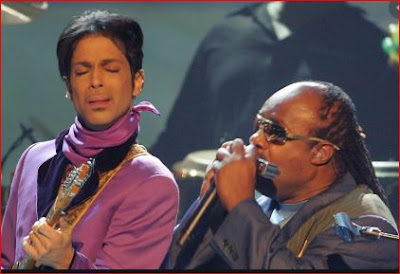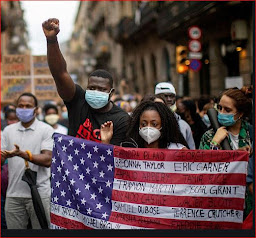SEE NO EVIL
This quite frankly may be one of the more extraordinary times of my life. Not necessarily the marching or protesting or the burning down of corporate-owned retail chains…, that is certainly nothing new. The historical hypocrisy of the red, white and—mostly especially—the blue isn’t really new either. America’s duplicity has always been the fabric used to strangle their most marginalized residents.
What is sort of novel, is the varying levels of discomfort that our white colleagues, peers and (cough, cough) friends have been pondering—some aloud. George Floyd’s televised lynching has sparked a discourse and (subsequent) movement in the world that hasn’t been seen in a really long time—maybe ever. And now for once in my life I can almost taste the “hope and change” that was promised by many false prophets—some with the same “colored” masks. We will certainly address that in a future soul session.
I believe that great art—particularly great music—is birthed out
of pain and struggle. And the
best music tends to provide a creative context for the civil and social unrest.
Therefore, if white people aren’t comfortable tapping a black or brown citizen on the shoulder to help rectify the situation, perhaps they need to pray that these protests won’t pivot from inclusion to retribution. And if praying to their "Kenny G” doesn’t move the curiosity needle, perhaps picking up an LP that every black household should have will help navigate through these unchartered tête-à-têtes.
For now, let’s turn our clocks back to January 7 B.C. (Before Chris) Dorner. On this day a black man named Mark Essex went on a vigilante-styled killing spree. Essex’s murderous rampage included the killing of three police officers during a siege at a Downtown Howard Johnson's in New Orleans. What triggered (no pun intended) Essex’s rage of terror was the Baton Rouge Police Department's lack of accountability of the two black students that were murdered by THEIR police department during a Civil Rights demonstration.
Mark Essex went full Nat Turner when he started targeting white policemen. He wanted the police to feel what he was feeling. He wanted them to see what the consequences were by enforcing laws in a nation with two distinctively different sets of rules. Essex wanted to retaliate for the police brutality against black people (sound familiar) in America. If you listen really closely you can almost hear Dorner’s golf clap from above.
Like in 2020, the Essex saga was just the tip of the iceberg of what would become a very stormy year. In fact, in February the United States dollar was devalued by 10% around the world—perhaps a mere coincidence.
Then in March, one of the biggest government scandals in history erupted. In short, a man named James McCord wrote a letter to a judge, admitting that he & co-defendants were pressured to remain silent about the government scandal and cover-up. The letter revealed that then-U.S. Attorney General, John Mitchell, was the mastermind of the operation.
The slippery state of events paused in April when the very first handheld cellular phone call was made in New York City. Apparently, someone used those technological advances the following month to dial 9-1-1 to report a lengthy, 71-day standoff, between federal authorities and the American Indian Movement activists that (now) boiled to a feverish pitch. The activists were forcefully occupying the Pine Ridge Reservation at Wounded Knee, South Dakota.
They were fighting for the equality that the Native Americans were promised (sound familiar). The physical location of the fight was no coincidence either. They chose the same location that the 1890 Wounded Knee Massacre took place. It sure sounds like Native American Lives Matters too.
This year limped to the midway point, in June when an arsonist attacked the UpStairs Lounge. The xenophobic act was literally set ablaze at a gay bar in New Orleans' French Quarter and it killed 32 people and injured countless others.
If you stir in an impeachment trial, add a flaming Wendy’s in Atlanta (pardon the pun), and mix in a deadly virus, it would be difficult to tell if we were discussing 2020 or the actual year in review..., 1973. July is the official start to the 2nd half of the year and obviously no one knows what we’ll see in the near future.
But, if music plays any role in the epilogue, hopefully someone will drop a bomb like one that shook the world on August 3, 1973.
 |
| Stevie Wonder I Innervisions I Tamla Records I August 1973 |
 |
Statues of Liberty |
Too High
Right from the start, the needle pokes the platter with a captivating, cautionary tale about the end game of drug
abuse. The song is so painfully graphic that you almost feel guilty bobbin' your dome to it. Underscoring the flat-out brilliant melody is blanketed by a woman trying to cope with life in the 70's through the aid
of some really potent weed. She gets so high from the smoke that after a few
puffs…she starts to hallucinate…. ‘It's a crazy scene.’/ that red is green/ and
she's a tangerine.” Clearly, she’s already too high. And before the track ends, her
friends have started to spread the news that she unceremoniously passed away.
Visions
Wonder’s immeasurable lyrics turn from the drug abuse on the opening
single to the gospel-enriched Visions.
Here, Wonder pounds the piano pondering whether this land of milk and
honey can ever really live up to its promise, or is this just a vision in our minds... (sound familiar).
 |
Ali & Stevie trade playful jabs |
Living For the City
Man….oh….man…. this is how legends are born.
Let’s start with the fact that Stevie performed the lead
& background vocals; which would’ve been enough for most artists to retire.
Then Wonder’s musical magic added: the piano, the drums, the moog bass and synthesizer
to his legendary LinkedIn list of skills. Even the hand claps on this social commentary
anthem belonged to the music icon.
The song rings of tears from a kid that grew up on the hardships in the Jim Crow south, although he was somewhat protected by his caring circle of people. He then rolled the dice and moved to the much faster paced north (minus the family circle) and ended up on drugs and doing 10 years in prison. The music and the lyrics are what soundtracks were built upon.
Wonder added this song to his list of 25 Grammy Awards wins—which ranks him 5th amongst all artists to-date. I’d be remised if I didn’t mention that Public Enemy used a portion of this song's bridge in their equally classic, Black Steel in the Hour of Chaos. A far less subtle sample was done on For The Love of Money, which is a rhyming rendition appearing on the New Jack City Soundtrack, by Queen Latifah & Troop. There has been a number of others to sample this track: Ice Cube, Wu Tang, Usher & Slick Rick, all of whom used this song to underscore their rebelliousness... well, maybe not Usher. 👀
Stevie Wonder could've added Milli Vanilli to the rest of this LP and it would still be one of the greatest masterpieces of all time. Failed humor aside, let's keep in mind that the year was 1973, and the political scandal referenced earlier was Watergate. Therefore, the Motown Great had much more to say—especially on the politically charged...
He's
Misstra Know-It-All
The single is a description of a “know-it-all trickster” whom, according to Wonder, is a character who is a "man with a plan..., who has a slick answer to all
his critics and who has a counterfeit dollar in his hand." It has
been widely speculated that this song is referring to then-U.S. President,
Richard “Tricky Dick” Nixon. Stevie has never confirmed nor denied that assertion.
He took the same position when others insinuated that the song was about
Motown's two-faced president, Berry Gordy, who was the P-Diddy of the 70's.
Higher Ground
There are endless antidotes that add to the legend of this amazing
song, not the least of which is that Stevie played every instrument on this song as well. Wonder often speaks on how he
wrote and recorded this single in a three-hour stream of consciousness. Higher Ground is a song about reincarnation—"sometimes while you are on earth,” said Wonder -- who also felt like this song was his second chance at life.
And in an eyry twist of fate, just three days after Innervisions was released, Wonder was involved in a near-fatal car accident that left him in a coma. There are varying degrees of what actually happened in the car that sunny afternoon.
But the most consistent part is..., about his manager...,who played Higher Ground over & over by Stevie’s bedside, which woke Stevie out of his coma. If you didn’t know that story before, you will probably never listen to that song the same again…, especially if retribution is the endgame for black lives in America.
1 ❤
Ray Lewis









